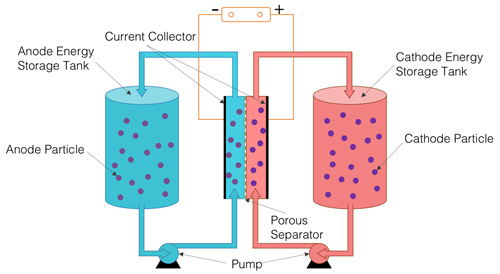Unleashing the Power of Energy Storage: Exploring Redox Flow Batteries
2023-08-03
In a world that increasingly relies on renewable energy sources, the need for efficient and reliable energy storage solutions has become paramount. Among the various energy storage technologies, Redox Flow Batteries (RFBs) have emerged as a promising contender, offering a unique set of advantages and potential applications. In this blog, we will delve into the fascinating world of Redox Flow Batteries, understanding their principles, advantages, and the role they can play in shaping the future of sustainable energy.
What is a Redox Flow Battery?
A Redox Flow Battery is a type of electrochemical energy storage system that operates on the principles of redox reactions. Unlike conventional batteries where the energy storage occurs within the cell, RFBs store energy in liquid electrolyte solutions, which flow through electrochemical cells during charging and discharging cycles. The basic components of an RFB include two tanks for storing the electrolytes, a stack of electrochemical cells, and a membrane separating the two electrolytes. During the charging and discharging process, the electrolyte solutions are pumped through the cells, facilitating the energy conversion.
How Does it Work?
The operation of an RFB is based on the redox reactions of the electrolytes. Each electrolyte contains specific active materials that undergo oxidation and reduction (redox) reactions. During charging, electrical energy is used to drive the redox reactions, converting the active material in one electrolyte into a higher energy state. The energy is then stored in the form of chemical potential in the electrolyte. During discharge, the opposite redox reaction takes place, converting the active material back to its lower energy state, while releasing electrical energy in the process. The flow of electrolytes through the cells allows the transfer of energy without the need for large-scale solid-state storage.
Advantages of Redox Flow Batteries
Scalability: One of the most significant advantages of RFBs is their scalability. By simply adjusting the size of the electrolyte tanks and the number of cells in the stack, RFBs can be easily tailored to meet different energy storage requirements, making them ideal for both large-scale grid applications and smaller, localized installations.
Long Lifespan: RFBs have relatively long lifespans compared to traditional batteries. Since the active materials are in liquid form and do not undergo significant chemical changes during operation, RFBs can endure many charge-discharge cycles without a substantial loss of capacity.
Safety: The use of non-flammable and non-toxic electrolyte solutions makes RFBs safer than some other battery technologies. Additionally, the separation of the energy storage from the power conversion allows for better heat management and reduces the risk of thermal runaway.
Deep Discharge Capability: RFBs can be discharged almost completely without affecting their performance or lifespan, unlike certain conventional batteries, such as lithium-ion batteries, which can suffer from capacity loss if fully discharged.
Applications of Redox Flow Batteries
Grid-Level Energy Storage: RFBs have great potential for storing renewable energy at the grid level. They can help balance the fluctuations in energy production from sources like solar and wind, ensuring a stable and reliable supply of electricity.
Peak Shaving: RFBs can be employed for peak shaving, where excess electricity generated during off-peak hours can be stored and discharged during peak demand periods, reducing strain on the grid and mitigating the need for expensive peaker plants.
Microgrids and Remote Areas: RFBs can be used in microgrid systems to store energy in remote or off-grid locations, providing a continuous power supply even in areas with limited access to the main grid.
Renewable Energy Integration: RFBs can play a vital role in integrating intermittent renewable energy sources into the existing power grid, improving grid stability and enabling a smoother transition to a greener energy future.
Conclusion
Redox Flow Batteries represent a promising energy storage technology that holds the key to unlocking the full potential of renewable energy sources. With their scalability, long lifespan, and safety features, RFBs offer a viable solution for grid-level energy storage and integration of renewables into our power systems. As technology continues to advance, it is likely that Redox Flow Batteries will play an increasingly significant role in shaping a sustainable energy landscape, ultimately contributing to a cleaner and greener future for generations to come.
